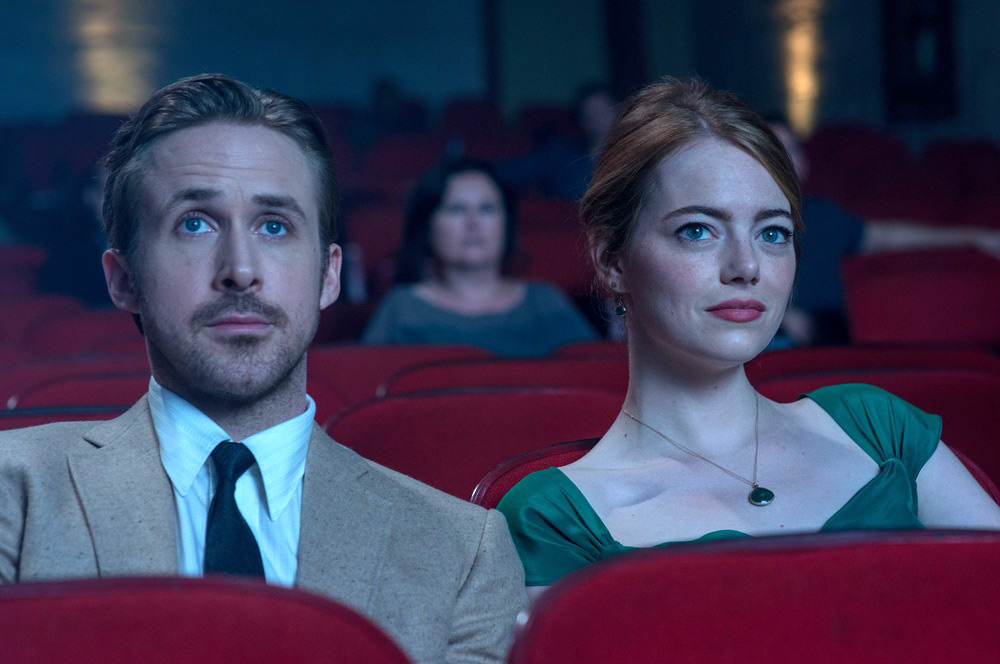Movie Review: La La Land
By Matthew Huntley
January 4, 2017
BoxOfficeProphets.com

Perhaps finding such a harmony between depth and spectacle is hard to do and explains why musicals are so rare these days compared to when they dominated Hollywood's Golden Age and remained prolific up through the 1960s. But La La Land made me believe there could be a resurgence because its quality and craftsmanship deserves comparison to the titles I mentioned above, which is saying a lot. At its heart is a bittersweet love story that feels real and pure and it's this element that writer-director Damien Chazelle keeps coming back to in order to make La La Land work as a thoughtful drama, while the music, lyrics and dance sequences give it an extra kick.
Emma Stone and Ryan Gosling star as Mia and Sebastian, the film's predestined couple who at first deplore each other but soon realize they may be soul mates. Mia is an aspiring actress who works at a studio cafe and lives with three roommates, who are also would-be actresses. Sebastian is a jazz pianist who'd rather promote classic jazz artists by opening up his own club than rehash the same old jingles in a mediocre restaurant where the owner doesn't allow him to be inventive. When Sebastian decides to put a spin on things, his tune catches the ears of Mia, who happens to be walking by. She goes in to compliment him, but he completely blows her off after his boss (J.K. Simmons) fires him.
This isn't Mia and Sebastian's first encounter - they initially crossed paths during a brief stint of road rage on a busy Los Angeles freeway, which follows the film's opening song and dance number, “Another Day of Sun,” during which the motorists mitigate the stresses of gridlock by singing and swinging their bodies. Everyone takes part except Mia and Sebastian, who are too concentrated on the next moves of their careers. They meet for a third time at a mutual friend's party, and soon thereafter the wheels of romance and destiny are set in motion, as is Mia and Sebastian's willingness to break out into their own song and dance sequences.
The movie is called La La Land for obvious reasons. Not only do Mia and Sebastian live in Los Angeles but they literally detach themselves from reality as they look into each other's eyes, fly through the air, and sing to one another and themselves, making the entire cityscape and the Hollywood Hills, particularly Griffith Park and its observatory, their own personal, moonlit stage.
The film is wonderfully romantic, fun and captivating as it follows Mia and Sebastian's blossoming and eventually tumultuous relationship through the four seasons of a year, but perhaps what's most enduring and surprising about it is how genuine their respective experiences in the film and music industries come across. This must stem from the fact that Chazelle himself is a young artist and it's clear his screenplay draws from his own personal experiences when it comes to the pain, frustration and financial hardships Mia and Sebastian must weather in order to achieve their hopes and dreams in show business. Their hurdles never seem exaggerated, right down to Mia's auditions and her attempting to put on a one-woman show, as well as Sebastian trying to convince himself that touring with a jazz band led by his former cohort (John Legend) is something he actually wants. We sense each character's anguish, both as career people and as one half of a couple struggling to find common ground. That brings up another surprise about La La Land: the outcome of Mia's, Sebastian's, and then Mia & Sebastian's, stories are never certain. How things wrap up - happy, sad or open-ended - I leave for you to discover.
And discover you should, because La La Land is alive and magical, deep and true. It's exceptionally produced and enormously entertaining, with not one scene where the energy isn't busting. If I had to criticize it, I'd mention that Emma Stone is probably better suited for the fantasy and Gosling the drama but that neither actor is one hundred percent right for both. Stone seems confined to the make-believe cloud upon which Mia floats, while Gosling doesn't seem like he's ever able rise to it with the same enthusiasm and conviction. His singing and dancing, in particular, feel unnatural.
I suppose one could argue this works in the film's favor and mirrors the characters’ respective natures, thus balancing things out, but when Stone tried to be dramatic or Gosling tried to perform, I was too aware of what they were doing and I ended up seeing the actors on-screen instead of their characters, which proved somewhat distracting. There's little doubt both leads will get an Oscar nomination, but to say they should win is a bit of a stretch.
Nevertheless, La La Land reminded me why musicals used to thrive. When they're done right, as this one is, they can be entertaining on so many levels: from their drama, comedy, and romance, to their music, songs and dancing. Of course, by taking on so much, they also run the risk of becoming overwrought and turning into an unfulfilling mess (Hello, Dolly!), but La La Land practices moderation and finds balance. It focuses first on its essential human story, which is about our inherent desire to feel special among our peers and to the person we love, and then on its music, dancing and technical presentation. The former makes it great; the latter make it greater.